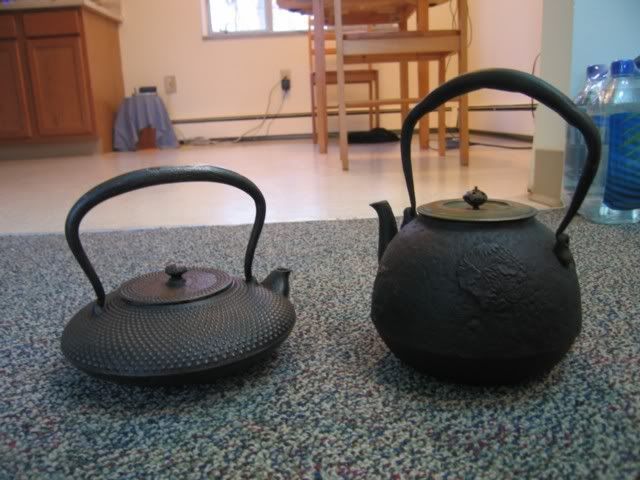Some of you may remember my Ebay misadventure post. Well, here are the kettles in question

The right hand one is the leaky one. The left hand one is the dirt cheap one that I bought in a hunch, somehow feeling that the first (i.e. right) one might be problematic. The right hand one is still leaky — I tested it. I’m going to try to get it fixed somehow, although, thankfully, the guy who sold it to me agreed to refund every penny of the cost and did so, including shipping. Gotta give it to him for being straight.
The reason I bought any at all was because my glass kettle broke on the way from Taiwan to here. Everything else was ok in my luggage, including the cups that Aaron gave me — in that case, a bit of a miracle because the wooden box they were stored in was totally smashed, but somehow the cups were ok. The glass kettle, however, was in a box that didn’t look damaged at all, but when I opened it, it was shattered. So I needed a replacement.
The left handed kettle works, in so far as one can boil water in it. However, it has some rust in it. That’s not the real problem. The real problem is that even after a number of tries boiling water and what not, water boiled using this kettle still comes out yellowish with a smell that most reminds me of chamomile. Anybody with a suggestion on how to get rid of such a smell? I’m thinking using some sort of chelation agent to get rid of the rust and see where that takes me…. suggestions welcomed.
So the hunt for a replacement kettle continues.

6 responses so far ↓
Anonymous // January 18, 2008 at 6:27 am |
I believe someone suggested this in your previous post, but I don’t think you replied on if you had tried this method or not, but Stephane posted about this with his post here http://teamasters.blogspot.com/2008/01/how-to-repair-crack-on-tetsubin.html
Someone on there also said it’s great for rust.
Anonymous // January 18, 2008 at 9:09 am |
Is it plain metal or has it been enameled?
If it is plain metal, an easy solution might be the same as for cast iron pots whose seasoning has failed until they rust- find a sympathetic sandblaster to scour out the inside. (Find a sandblasting shop willing to work with you on masking so that only the inside is sandblasted. ask them to use a really fine grit so the inside isn’t etched too harshly.
Another possibility if rust isn’t the problem, is hydrogen peroxide bleach- hit the beauty supply shop for the strong stuff, warm the kettle and fill it with a strong solution. This stuff is really potent- Beekeepers sometimes use this stuff to bleach some beeswax really white, and not only does it whiten the beeswax, it removes all fragrance from the wax.
If you want to try a more gently version try the stuff from the pharmacy. I don’t think you want to use the laundry product because most contain perfumes and stuch.
MarshalN // January 18, 2008 at 9:49 am |
Unfortunately, the rice thing definitely won’t work. The hole is right in the middle of the bottom of the pot — where the flame will be. Whatever film the rice forms will probably be burned out by the flame. Rice is a great thing to use as a glue between surfaces, but this is a little more serious than that.
I might try the bleach… rust isn’t really a big problem. Regular clorox with no perfumes should work, no?
Anonymous // January 18, 2008 at 2:09 pm |
The way to repair the pot with the hole in it is to take it to a welding shop. They can braze the hole shut with brass. Don’t let them try using an electric welding cast iron rod, it will cause the pot to crack in almost all cases. Cast iron is almost impossible to weld, but brazing is relatively simple and easy to do. Since it is on the bottom of the pot it will not be very noticeable. As to the rust… Wire brush the pot and keep boiling water in it until it is well coated with calcium scaling. I would not want to drink water from it after using any of the many rust inhibiting chemical products.
MarshalN // January 18, 2008 at 2:38 pm |
Yeah, I actually thought about using, say, bottles of evian heavily mineralized water and boil them dry. After a few times hopefully there will be calcium deposits on the thing.
Anonymous // January 20, 2008 at 2:55 pm |
RE; Chlorox bleach
The hair and pharmacy bleaches I recommended are Hydrogen peroxide bleach- an oxygen based bleach that when it breaks down, breaks down into water.
Chlorox is a completely different chemical- sodium perborate, IIRC. Sodium perborate is awesome for breaking down proteins- it will actually dissolve silk and wool, but it can leave a chemical residue and smell that can be hard to get rid of.
Since iron is usually non-porous, it will probably come out, but Hydrogen peroxide is an all around safer product to use since it breaks down into plain old water.